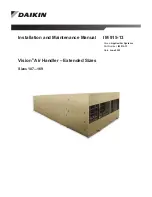
29
Fig. 51 — Equipment Configuration
The equipment configuration screen shows the configuration by
component, which dictates how the unit will be controlled/operat
-
ed. The parameters on this screen are set by the factory to match
the unit order configuration.
NOTE: Changes to the equipment configurations should only be
modified by factory trained personnel after consulting with Carrier
technical support. Changes to the equipment configuration will af
-
fect unit operation and may cause equipment damage or perfor
-
mance issues. Additional components may be required for a
change in equipment function to be made. Any changes in these
settings will also change the associated set point for the changed
component.
Table 8 shows a summary of all possible options. Below is an ex
-
planation of some the key options that may need to be field con
-
figured.
SF OPTION
Determines how the unit supply fan is controlled. Common con
-
figurations include:
• SFVFD AMS - unit has a supply fan airflow measuring
station and will modulate the SF to maintain the SF AMS
CFM set point
• SFVFD CAV - SF will operate at constant air volume
• SFVFD DPT (Zn,Bldg) - unit has zone (building) pressure
sensor and will modulate the SF to maintain the zone pres
-
sure set point
• SFVFD DPT (Duct) - unit has a duct pressure sensor and
will operate the SF to maintain the duct pressure set point
• SFVFD ZAT - Not used with 62X
EF OPTION
Determines how the unit exhaust fan is controlled. Common con
-
figurations include:
• None - no exhaust fan
• EFVFD AMS - unit has an exhaust fan airflow measuring
station and will modulate the EF to maintain the EF AMS
CFM set point
• EFVFD CAV - EF will operate at constant air volume
• EFVFD DPT (Zn,Bldg) - unit has zone (building) pressure
sensor and will modulate the EF to maintain the zone pres
-
sure set point
• EFVFD DPT (Duct) - unit has a duct pressure sensor and
will operate the EF to maintain the duct pressure set point
• EFVFD ZAT - Not used with 62X
HGRH OPTION
Determines how the reheat system functions. Should match the
unit configuration. Common configurations include:
• Lead - unit has HGRH on the lead circuit
• Both - unit has HGRH on both circuits
• Mod - unit has modulating HGRH
• SC - unit has subcooling reheat before the HGRH
• By Heating Only - use heat source for reheat. Not used
with 62X.
DEHUM OPTIONS
Determines how dehumidification mode functions (cooling & re
-
heat). Common configurations include:
• OADP/ECDP vs SADP - enables dehum mode when the
incoming air dew point is above the supply air dew point
set point
• OAE/ECAE - enables dehum mode when the incoming air
enthalpy level is above set point
• SARH - enables dehum mode when the supply air RH% is
above set point
• ZADP/ZARH - enables dehum mode when the zone air
dew point or RH% is above set point
• MADP/MAE/RARH - Not used with 62X
HEATING OPTIONS
Determines how the heating system functions. Should match the
unit configuration, unless field installed heat is being added (duct
heater).
COOLING ENABLED BY
Determines when cooling mode is enabled. Common configura
-
tions include:
• OAE/ECAE - cooling is enabled when the incoming air
enthalpy is above set point
• OAT/ECAT- cooling is enabled when the incoming air
temp is above set point
• OAT/ECAT vs SAT - cooling is enabled when the incom
-
ing air temp is above the supply air temp set point
• RAT/ZAT/None - not for use with 62X
HEATING ENABLED BY
Determines when heating mode is enabled. Common configura
-
tions include:
• OAT/ECAT - heating mode is enabled when the incoming
air is below the heating enable set point
• OAT/ECAT vs SAT - heating mode is enabled when the in
-
coming air is lower than the SAT set point
• RAT/ZAT - not for used with 62X
TEMP OPTIONS #1
Determine what temperature sensors the 62X supply control will
look for. Common configurations include:
• OAT, SAT - for units without ECW. Unit will have outdoor
air and supply air temperature sensors.
• OAT, ECAT, SAT - for units with ECW. Unit will have out
-
door air, entering coil air (after ECW), and supply air tem
-
perature sensors.
• All others - not used with 62X.
TEMP OPTIONS #2
Determine what temperature sensors the 62X exhaust control will
look for. Common configurations include:
• None - for units without ECW.
• WExAT, RAT - for units with ECW. Unit to have wheel
exhaust air and return air temp sensors. Used for ECW de
-
frost operation.
• All others - not used with 62X.












































